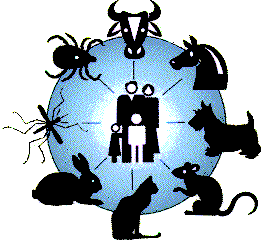anth g6085

zoonosis
chris alley (columbia university)

kj
Zoonosis is the category of infectious disease that comprises all the diseases that result when some microbial material – whether in the form of bacteria, virus, or prion – crosses species boundaries (CDC 2005; Murray et al. 2000). Usually in zoonotic diseases, the microbial presence is unproblematic in the sending species (i.e., the originating species) and only becomes an observable problem – a case with symptoms – in the receiving species. Zoonoses pose serious problems for public health; An estimated 50 million people caught diseases from animals between 2000 and 2005 (World Health Organization; CDC 2005). And yet few people have ever heard the term ‘zoonosis’. It is rarely reported on, as such, by the media, although specific zoonotic diseases are in the media all the time. One does not even hear much discussion of zoonoses in departments of epidemiology or departments of infectious disease, even though zoonotic diseases are at the very top of their agendas. There is, in short, a striking omission from daily discourse on health and illness – at both the popular and technical scientific level – of significant mention of zoonoses. And yet they pose some of the greatest historical and contemporary threats to public health.
Consider just a few familiar examples: Anthrax (from cows), Ebola Virus, Bird Flu, Rabies (dogs), Toxoplasmosis (cats), “Mad-cow” disease, or bovine spongiform encephalopathy, West Nile Virus, and SARS. All come from animals to humans. The Bubonic Plague was zoonotic. Malaria and dengue fever are both zoonotic, if one includes mosquitoes. And so is public health Enemy #1: HIV, which consensus holds to originally have been transmitted from monkeys. Medical anthropologists will probably be increasingly called to study zoonosis in order to elucidate how these diseases are promoted by culture, such as bush-meat hunting practices that lead to Ebola, the sale of live wild animals that leads to SARS, intense farming and sale of different animal species next to each other that leads to avian influenza, or deforestation and building of dams that leads to leishmaniosis and Rift Valley fever. The stakes were recently raised with the threat of using zoonotic pathogens as bioterrorism agents, as demonstrated in the case of anthrax sent through the mail. Another source of great concern is the unpredictability of the brave new world of xenotransplantation experiments, which involves the surgical transfer of animal parts into humans. In any case, the point is that zoonoses are a significant problem for humans. And yet, to better confront this problem it behooves us to move beyond thinking about zoonoses only in relation to humans.
Zoonoses need to be seen as organisms in their own right and in their transcendence of any organismic level. We will return to this idea of simultaneous essence and transcendence, but first let us address zoonoses in terms of the subject-object divide. Humans do not accord zoonoses species status, but still they organize themselves into collectivess. They evolve, expand, colonize. They respond to their own environments. They exert remarkable influence on other organisms, instigating coordinated responses in immune systems. Sometime they cause ruination (as with plague). At other times they prompt feats of creativity (as when humans scramble in their laboratories to extinguish them). They are neither human nor animal. But do they not have some kind of agency, which – if measured by the havoc they wreak – is substantial? If animals represent a middle-zone of quasi-subjects, then zoonoses complicate the subject-object split further still.
One could approach the problem by exploring the gray area of zoonotic subjecthood. Why, it could be asked, is there this prejudice preventing our recognition of microbes as subjects? What impediments to imaginative creativity stop us from conceiving of agency as infinitely expressive? On these grounds one could spend time advocating for a new biological democracy, a la Latour (see Latour 1990 and 1993), but I suspect what that would really mean is just the articulation of a biological anarchy that is mostly kept in check by the smarter subjects. Besides, is it not really only humans that organize democracies? This is not to say that non-humans do not cooperate with each other, but rather to question whether just how distinctly certain members of non-human groups are elected by their peers to represent the group. Still, it may well be a profitable train of thought to consider these microbes in terms of power or biopolitics. For example, according to Donna Haraway the immune system itself can be considered a biopolitical map (Haraway 1989). For her, the immune system is the biological system responsible for recognition or misrecognition of the self – it is what adjudicates challenges to the sovereignty of the self. This approach may help prevent the overprivileging of our human selves by acknowledging that zoonoses cause disputes in a variety of subjective contexts, often times (and who knows? – perhaps most of the time) occurring in contexts from which humans are completely absent. But still this reasoning renders the zoonotic microbe’s existence contingent upon some Other, when what needs to be done is to flesh out what zoonoses mean on their own terms, without any quarrel with an immune system gatekeeper, human or otherwise.
The term zoonosis itself originated in the 19th century when the prefix zoo (meaning, “of animals”) was added to the Greek nosos (meaning, “disease”) (Oxford English Dictionary online). First of all, this definition elides the developmental history of these little critters. It is curious that we do not have a word to specify those diseases that humans spread to animals, or that animals spread among themselves; those are just matters for “veterinary medicine.” Of course, where microbes do not present a problem, or where their potential for disease lies dormant (what medical science refers to as “latency”), we assume there is little reason to be concerned. But this is precisely the reason we need to recognize zoonoses independently of humans, as sovereign objects Henceforth, then, this project refers to Harman’s ideas about the ‘carpentry of things’ as a way of distancing ourselves and other selves from the interpretation zoonoses. In asking zoonoses what they want only when they cause trouble for us or others, we miss the point full of painful [or at least sensual] ramifications that their qualities exist prior to the vicarious cause that arises with their confrontation with an immune system that has not yet mastered them. If we strip the term ‘zoonosis’ of its anthropocentrism, we see that its intended conceptual thrust is really to identify malign boundary breaches. And breaches are a kind of interaction with identifiable antecedents. They are a violation of space and/or time whose claimants had a prior existence. The sojourn of bacteria in a host body might be innocent so long as they do not effect an offensive style. But in those exchanges where their essential nature is read as noxious, they become imperative objects, demanding attention from without where they otherwise might be content to stay within. It is with our human interactions in the sensual medium of life that zoonoses emanate their invasive quality. And yet surely invasion is not their only quality; perhaps zoonoses posses qualitative shapes or vibrations. But let us not flatter ourselves by presuming that zoonoses reserve any of their qualities for only us, for their emanation also happens at other levels. Not only do they manifest in non-human species, but surely their reality is also to be found on an unused glass slide catalogued for some possible future use under the microscope, or in the air through which they waft unperturbing to anyone or anything…Or, let us state it more generally – zoonotic microbes might just be endemic not only to life on earth, but, like everything, to the ether itself.
Despite their meager size, these microbes play very large roles, and with the development of a new ‘xeno-science’ that expedites the deliberate commingling of animals and humans in the laboratory and operating room, it will become increasingly apparent that they are a denominator of evolution and not merely a dangerous incidental. In the xenofied future, the zoonotic domain will not be so easily overlooked as a distant diagnostic designation, but will take front and center as the complex and crafty resistance – as loci of disruption and as networks of actants (i.e., as essential threat and as “man with zoonosis”). After all, zoonoses are only noses in medicine. But they are also things outside of human language. Their existence bespeaks – to borrow Brown’s phrase - a sort of ‘anterior physicality’ of the quotidian physical world we see emerging (see Brown 2001). They are one out of many conceptual preconditions for biological change, but are also encountered as real. They transcend notions of fixed life-form by virtue of their plasticity and diminutive size, but they are experienced by life-forms as essential subtle material with larger than life consequences. In short, we are compelled to attend to zoonoses only as much as we are compelled to attend to life general.
references
Brown, B. (2001). “Thing Theory.” In Critical Inquiry 28 (1): 1-22.
Centers for Disease Control and Prevention (2005). "Compendium of Measures To Prevent Disease Associated with Animals in Public Settings, 2005: National Association of State Public Health Veterinarians, Inc. (NASPHV)". MMWR 54 (No. RR-4).
Haraway, D. (1989). “The Biopolitics of Postmodem Bodies: Determinations of Self in Immune System Discourse.” In Differences, Vol. 1, pp. 3-43.
Harman, G. (2005). Guerrilla Metaphysics: Phenomenology and the Carpentry of Things. Chicago: Open Court.
Latour, B. (1990). “Postmoderm? No, Simply Amodern!: Steps Toward an Anthropology of Science.” In Studies in History and Philosophy of Science, Part A, Vol. 21, Issue 1, March, pp. 145-171.
Latour, B. (1993). We Have Never Been Modern. Cambridge: Harvard University Press.
Murray, et al. (2005). Medical Microbiology. 4th Edition, Chapter 26, pp. 245-249; Chapter 29, pp. 276-278, and Chapter 33, pp. 309-315. Mosby Publishers.
World Health Organization (WHO). Zoonoses and Veterinary Public Health. Accessed at http://www.who.int/zoonoses/en/ on 16 May 2008.
kj